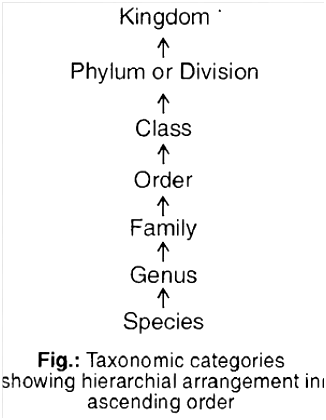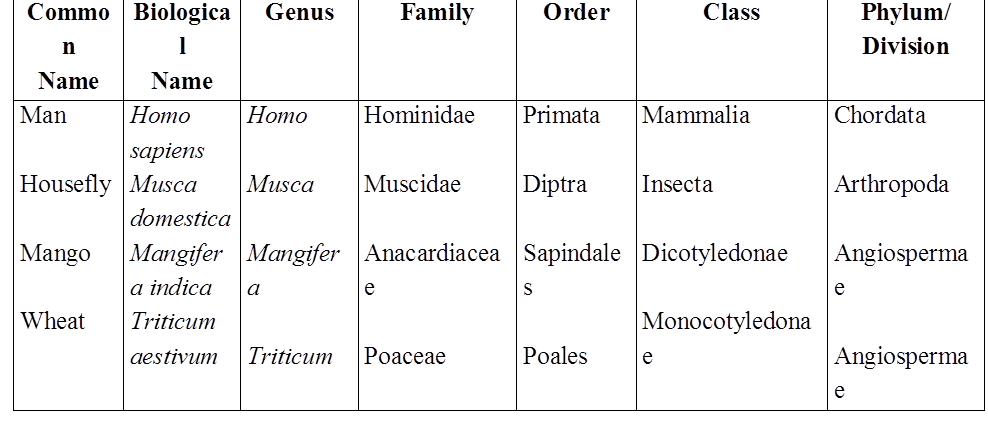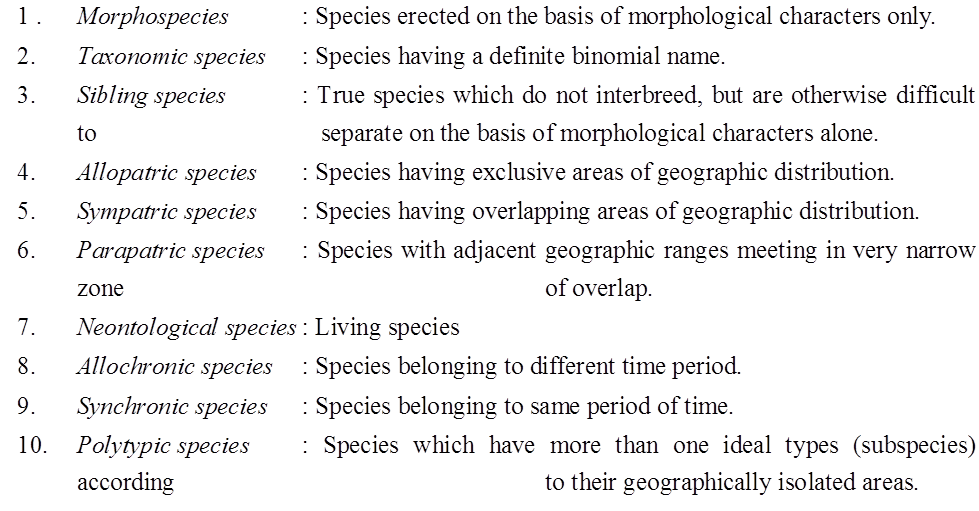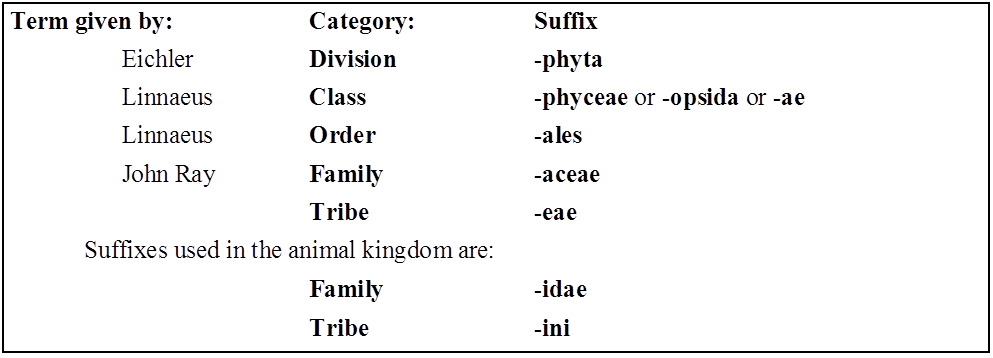- Books Name
- ACME SMART COACHING Biology Book
- Publication
- ACME SMART PUBLICATION
- Course
- CBSE Class 11
- Subject
- Biology
TAXONOMIC CATEGORIES

Classification is not a single step process. It involves hierarchy of steps in which each step represents a rank or category.
The category is a part of overall taxonomic arrangement. All categories together make taxonomic hierarchy.
Each category is also termed as a unit of classification. It represents a rank and is commonly called as taxon.
The taxon must be recognisable and order should belong to a category.
Taxonomic hierarchy is a series of different ranks placed in ascending or descending order.
It was Linnaeus who for the first time introduced five categories in the taxonomic hierarchy, viz., class, order, genus, species and variety.
Later on three more categories, viz., kingdom, division or phylum and family were added.
Variety was Species discarded to make a hierarchy of seven obligate categories.
Taxonomic categories kingdom -division (in plants) or phylum (in animals) -class -order -family -genus -species. (descending order)
Higher the category, higher is the number of organisms in it. Higher the category, fewer will be the number of common characters and greater is the difficulty of determining the relationship to other taxa at the same level. Hence, the problem of classification becomes more complex.
Taxonomic categories and hierarchy can be illustrated by an example. Insects represent a group of organisms sharing common features like three pairs of jointed legs.
It means insects are recognisable concrete objects which can be classified, and thus were given a rank or category.
Similarly, mammals represent animals with external ears, body hairs, mammary glands etc. Dog, mammals, animals are all taxa but of different categories.
Taxon dog, mammals and animals represent categories like species, class and kingdom respectively.
Species:
Term given by John Ray. It is lowest category of classification. It is a group of closely related individuals with similar morphological, anatomical, biochemical and cytological characters.
It is a group of naturally interbreeding population with the ability to produce fertile offsprings.
Individuals of a species share common gene pool.
It is reproductively isolated, thus genetically closed system.
e.g, Pisum sativum – Pea
Mangifera indica – Mango
Solanum tuberosum – Potato
Panthera leo – Lion
Homo sapiens – Human being
In these, sativum, indica, tuberosum, leo, sapiens represent the specific epithet, while Pisum, Mangifera, Solanum, Panthera and Homo represent genus.
Genus:
Genus is a group of related species. Species has more characters in common in comparison to species of other genera.
e.g., Potato, (Solanum tuberosum), makoi (S. nigrum) and brinjal (S. melongena) are three different species belonging to same genus Solanum.
Lion, leopard and tiger with several common features belong to the same genus Panthera.
Family:
It is a group of related genera with still less number of similarities as compared to genus and species. Families are characterised on the basis of both vegetative and reproductive features of plants.
For example, four related genera Solanum, Petunia, Datura and Atropa belong to the family Solanaceae. Genus Panthera and Felis (cat) are put together in family Felidae.
Order:
It is a group of related families which exhibit a few similar characters. The similar characters are less in number as compared to different genera included in a family.
For example, plant families like Convolvulaceae and Solanaceae are included in order Polymoniales mainly based on floral characters.
In animals, order carnivora includes families like Felidae (cat) and Canidae (dog).
Class:
It is a group of related orders.
For example , plants order like Sapindales (mango) and Polymoniales are included in Class -Dicotyledonae, Order -Volvocales (Volvox) and Conjugales (Spirogyra) are included in Class -Chlorophyceae (green algae).In animals, order Primata (man, monkey) and Carnivora (cat, dog) are included in class -Mammalia.
Phylum/Division :
It is a group of related classes.
The phylum Chordata of animals contains not only the class mammalia but also aves (birds), reptilia (reptiles) amphibia (amphibians) and osteichthyes (fishes).
In case of plants, classes with few similar characters like dicots and monocots constitute division -Angiospermae.
The category phylum is used in animalia while division is used in plantae.
Kingdom:
It is highest category in hierarchy with related phylums or divisions.
Kingdom animalia includes all animals belonging to different phyla. Kingdom Plantae includes all plants of various divisions.

Concept of Species :
Biological concept of species (was given by Ernst Mayr) : Species is the fundamental unit of classification. A species is a group of organisms (i) which are closely related (structurally and functionally) sharing a common gene pool (ii) which can interbreed freely in nature and produce fertile offspring in a natural environment. This concept of species is based upon reproductive isolation and called biological concept.
Some important interspecific hybrids (exception of biological concept of species)
(i) Sterile Hybrid (under natural conditions)
Mule = Between male donkey and female horse (Mare)
Hinny = Between male horse (Stal'lion) and female donkey
(ii) Fertile Hybrid (under captive conditions)
Tigon = Between male tiger and female lion
Liger = Between male lion and female tiger
Types of Species :

Concept Builder
In accordance with International Code of Botanical Nomenclature, the names of different categories must end in the standard endings (suffixes) given below :

Tournefort gave the term genus and John Ray gave the term species
(b) Names of some families are changed according to ICBN rules for suffixes.
Old Name New Name
Palmae Arecaceae
Graminae Poaceae
Leguminosae Fabaceae
Compositae Asteraceae
Cruciferae Brassicaceae
Umbelliferae Apiaceae
Labiatae Lamiaceae
Guttiferae Clusiaceae
(c) Tribe is an intermediate category between sub-family and genus.
(d) In asexually reproducing organisms, physical resemblances and differences are used for delimiting species.
(e) Basic function of biological classification :
- (a) Recognition and description of species.
- (b) Grouping the species on the basis of similarities and relationship.
- (c) To establish evolutionary relationship amongst different organisms.
(f) The genera which have more than one specific epithets, are known as polytypic.
Lion – Panthera leo
Leopard – Panthera pardus
Tiger – Panthera tigris
(g) There are 7 obligate categories and about 21 intermediate categories. Prefixes: sub-and super-used for intermediate categories.
(h) Species name is given on the basis of some characters or habit, colour and distribution, e.g., niger (black), alba (white), tuberosum (tuber).
(i) Taxon is a group of real organisms which is assigned for any category. It is the unit of classification for any rank. Term taxon was introduced by ICBN in 1956 and defined by Mayr (1964).
(j) Category is an abstract term and represents only rank or level in a hierarchy and does not represent the living organisms. Example: Reptile is taxon but reptilia is category.
(k) Typological concept of Species
It was proposed by “Aristotle” and “Plato”. According to this concept, “There is a definite type or pattern of characters are present in the each species and all the members of species shows maximum resemblance with this pattern”. The species in which one fixed pattern of characters is present are called as monotypic species. e.g., Bacteria, Blue green algae if more than one type of pattern of characters are present. These are called “Polytypic species” or “Macrospecies”. e.g., Brassica oleracea Cauliflower, Cabbage, Knol-Knol.
Type of Polytypic Species :
Biotype : Members of same species inhabiting similar environment and having some genetic variations are known as biotypes. Variations found in these members are permanent. These members can not interbreed among themselves. e.g. Cauliflower, Cabbage, Knol-Khol are three biotypes of one species
Ecotypes : Members of same species inhabiting different environment and having some genetic variations are known as ecotypes. Variations are permanent. These members can interbreed among themselves but due to geographical barrier they can not interbreed.
e.g., Crow (Corvus splendense) found in different regions are ecotype of one species
Corvus splendense splendense - Indian crow
Corvus splendense insolense - Myanmar crow
Corvus splendense protegatus - Srilankan crow
Ecospecies : It contains one or more ecotype which although interfertile (capable of interbreeding), but do not produce viable offsprings due to some natural interruption (mountain, ocean etc).
Ecads or Ecophenes : Members of same species having some non genetic variation due to environment. These variations are temporary.
e.g.,


 Maria Habib
Maria Habib
